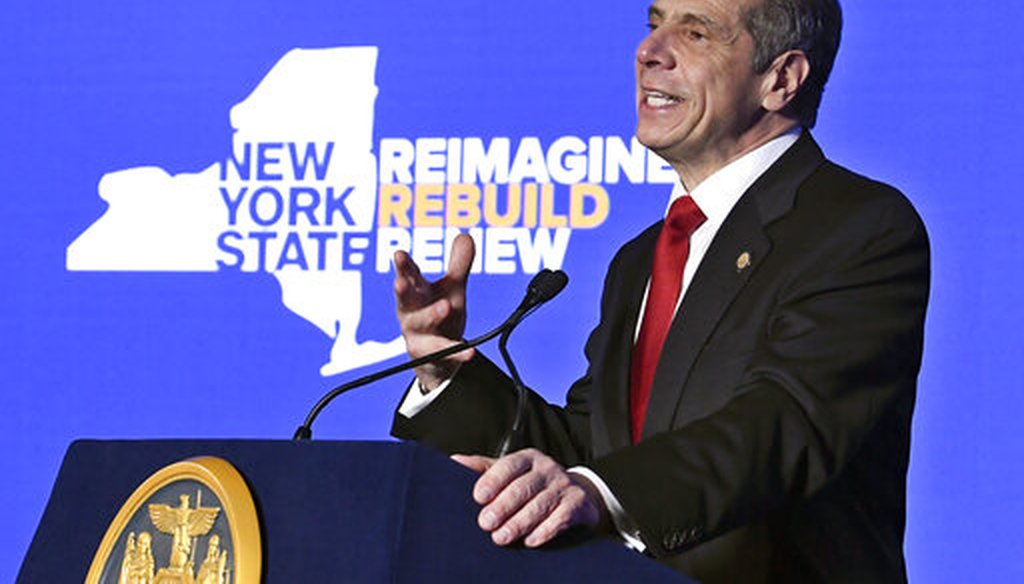Stand up for the facts!
Our only agenda is to publish the truth so you can be an informed participant in democracy.
We need your help.
I would like to contribute

New York Gov. Andrew Cuomo delivers his State of the State address virtually from the state Capitol in Albany on Jan. 11, 2021. (AP)
Does New York get less from the federal government than any state?
If Your Time is short
-
Cuomo’s assertion aligns with a widely cited study by the Rockefeller Institute of Government that looked at every state’s balance of payments with the federal government between 2015 and 2018.
-
However, that same study notes a slightly different result over the same four-year period when population is taken into account. On a per-capita basis, New York ranked fourth, after Connecticut, New Jersey and Massachusetts.
Does New York get the short end of the stick when it comes to federal funding? Gov. Andrew Cuomo said so in a tweet on Jan. 14.
"New Yorkers are just tired of subsidizing other states with our tax dollars. New York subsidizes 42 other states. No state gets back less from Washington than New York state. The federal government must stop shortchanging NY," Cuomo tweeted.
Is Cuomo correct that "no state gets back less from Washington than New York state"?
We looked at a comprehensive independent analysis and found that Cuomo’s assertion was close to accurate.
The governor’s evidence
Freeman Klopott, a spokesman for the New York State Division of Budget, told PolitiFact that Cuomo was referencing a widely cited analysis from the Rockefeller Institute of Government, a public policy arm of the State University of New York.
The report, published in January 2020, shows four-year totals of funding flows from fiscal year 2015 to fiscal year 2018.
The report found that New Yorkers cumulatively sent $116 billion more to the federal government during that period than New York state received from the federal government.
The four major categories of federal spending analyzed by the report are direct payments for individuals under programs such as Social Security and Medicare, federal grants to state and local governments, federal contracts and procurement, and wages paid to federal workers.
The institute found that during that period, only 11 states received fewer dollars in funding than they sent to the federal government in tax payments — and of these, New York’s cumulative shortfall was easily the largest.
The other 10 states with negative balances with the federal government during that four-year period were, in descending order, New Jersey, Massachusetts, Connecticut, California, Illinois, Colorado, Nebraska, Washington, Utah and New Hampshire.
In the most recent year studied in the report, 2018, New York sent almost $22 billion more to the federal government than it received. That’s a larger sum than the next two states’s shortfalls combined, New Jersey and Massachusetts.
But when adjusted for population, New York isn’t the biggest loser. It’s fourth, after three of its smaller neighbors: Connecticut, New Jersey and Massachusetts.
Cuomo’s mention of 42 states stems from the 2018 figures in the report, which says, "Forty-two states had a positive balance of payments with the federal government in 2018,
Why does New York pay so much?
Broadly speaking, federal money flows from high-income states to low-income states through spending by programs such as Medicaid. The system isn’t designed to give back each state the equivalent of what its residents and businesses paid.
"Because New York is home to a large critical mass of very high-income households, as well as a considerable number of merely very affluent (mid-six-figure) residents, the Empire State’s residents generate a disproportionately large share of federal revenues through a tax system that is, after all, based on a progressive income tax," said E.J. McMahon, founder and research director of the Empire Center for Public Policy, a free-market think tank.
New York’s balance of payments with the federal government could worsen in the coming years unless a change made to the tax code in 2017 is reversed. In the Republican-backed tax bill signed that year by President Donald Trump, lawmakers limited the size of the federal deduction for state and local taxes paid. This change to the state and local tax deduction meant that some taxpayers in high-tax states like New York would pay more in federal taxes.
Our ruling
Cuomo said that "no state gets back less from Washington than New York state."
This aligns with a widely cited study by the Rockefeller Institute of Government that looked at every state’s balance of payments with the federal government from 2015 to 2018.
However, that same study notes a slightly different result when population is taken into account. On a per-capita basis, New York ranked fourth, after Connecticut, New Jersey and Massachusetts.
We rate the statement Mostly True.
Our Sources
Andrew Cuomo, tweet, Jan. 14, 2021
PolitiFact New York, "Is New York a ‘giver state’ to the federal treasury?" Nov. 2, 2018
PolitiFact New York, "Cuomo’s claim on New York’s contributions to federal treasury needs clarification" May 5, 2020.
Rockefeller Institute, report, "Giving or Getting, New York’s Balance of Payments with the Federal Government," January 2020
Rockefeller Institute, report, SALT Economic Impact, May 14, 2020
SmartAsset, Changes to the State and Local Tax (SALT) Deduction - Explained, Jan. 21, 2021
Email interview with E.J. McMahon, founder and research director at the Empire Center for Public Policy, Feb. 1, 2021
Interview with Freeman Klopott, press officer at the New York State Division of the Budget, Jan. 29, 2021
Browse the Truth-O-Meter
More by Cassidey Kavathas
Does New York get less from the federal government than any state?
Support independent fact-checking.
Become a member!
In a world of wild talk and fake news, help us stand up for the facts.
































